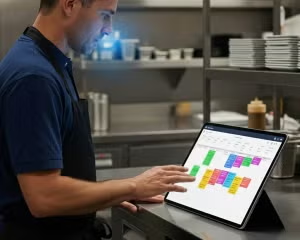It’s no secret that anyone at any age learns best by doing. The best instructor-led demos can’t beat hands-on experience, and the same goes for lessons in a kitchen setting.
Experts in health and education fields say that’s the secret behind the success of Teaching Kitchens. They are a resourceful hands-on experience that benefits residents in senior living and nursing homes as well as students, helping them eat healthier and remain active.
Why the Teaching Kitchen Concept Works
Dana Fillmore, RD, customer service marketing manager at Gordon Food Service®, said Test Kitchens combines instruction using healthy ingredients, nutrition education, and meal preparation skills.
“Teaching Kitchens are a great way to introduce new foods and teach cooking skills,” she said.
She highlights that the Teaching Kitchen format engages your audience in a meaningful and social way, hopefully influencing long-term physical, mental, and emotional wellness.”
There is no shortage of ideas when it comes to creating a successful Teaching Kitchen event. Here are a few suggestions:
- Teach a group of students how to prepare a nutritious after-school snack
- Get new college students prepared to cook healthy breakfast
- Engage seniors and show them how to make easy, healthy meals
- Show someone newly diagnosed with diabetes how to prepare a balanced dinner
- Teach an elderly couple how to make simple recipes for two
- Introduce a new menu item to a group of residents in a retirement community
The main purpose of the Teaching Kitchen is to bring attendees together over conversations about food and ultimately have them come away with a positive experience and new ideas to implement on their own.
Getting Started
Whether you’re hoping to generate revenue by charging for a Teaching Kitchen event, or offer the service as part of your overall program, you want to be prepared. You’ll need to narrow down your audience, make sure your message aligns with your vision and have a concrete idea of what your outcome will be.
The event should be structured in a way that has you set up for success. The following tips should set you in the right direction:
- Safety first: Are you using knives in your presentation? Is it safe for your audience to use sharp knives?
- Scope out the right room: Are there enough electrical outlets for your presentation, and do you have the right equipment available to host the participants?
- Limitations: Do your audience members have any food allergies or dietary restrictions?
- Simplify: Prep some of your ingredients ahead of time. Are there some ingredients you could portion out in advance?
- Personalize: Create a comfortable atmosphere that encourages the group to get to know each other.
- Provide name tags for participants
- Have the group introduce themselves
- Have a volunteer read instructions
- Ask questions of the group: What are some of the challenges they have of eating healthy? If you plan to return, what type of recipe would they like to see next?
Implement Teaching Kitchens in Your Operation
Overall, Teaching Kitchens should be a fun, easy way to share ideas, give consultation and really help your participants embrace and enjoy healthy nutrition. And learning from your team will be a great way for your audience to pass those lessons on to others!
For more information, contact your Gordon Food Service® sales representative for material on “Teaching Kitchens: Introducing new foods and cooking skills.” This resource will help you plan your Test Kitchen with available demo scripts. Each script provides a standardized recipe with a list of ingredients and equipment, prep tips, and a relevant message on nutrition.












